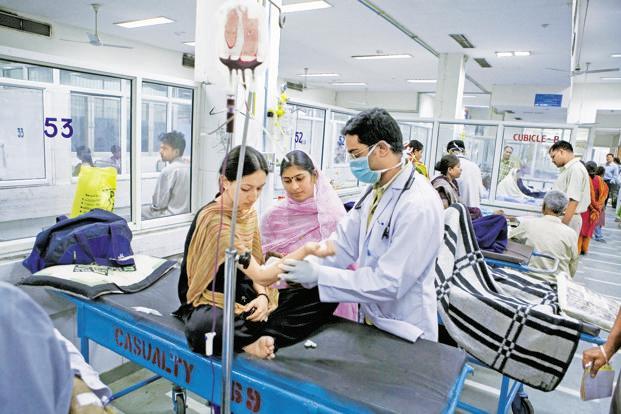India’s Healthcare System Struggles With Rise in Non-communicable Diseases

Image Courtesy: Livemint
In the last three decades, India has undergone major changes in all fields -- social, economic, and political. In this period, the country has also undergone a major epidemiological transition. The epidemiological transition describes changing patterns of population age distributions, mortality, fertility, life expectancy, and causes of death. Since 1990, the country’s disease patterns have shifted -- mortality due to communicable, maternal, neonatal, and nutritional diseases has declined substantially, and non-communicable diseases and injuries are increasingly contributing to overall disease burden.
India’s healthcare system is, therefore, facing a dual challenge. Although the burden from diseases such as diarrhoea, lower respiratory infections, tuberculosis, and neonatal disorders is being reduced, it still remains quite high in most of the states across the country. On the other hand, the contribution of non-communicable conditions such as heart diseases, stroke, and diabetes to health loss are rising.
Even though the burden of non-communicable diseases has grown substantially in the last three decades, India still does not have sufficiently detailed data on the diseases for research and policy purposes. In 2017, as a part of the Global Burden of Diseases, Risk Factors, and Injuries (GBD) Study, the India State-Level Disease Burden Initiative Collaborators produced an analysis of state variations in epidemiological transition levels.
Also Read: Overburdened Docs, Ill-equipped Hospitals: Chronic Disorder Continues to Grip Public Health
The initiative was launched in October 2015, and is a collaboration between the Indian Council of Medical Research (ICMR), the Public Health Foundation of India (PHFI), Institute for Health Metrics and Evaluation (IHME), and senior experts and stakeholders, from about 100 institutions across India. They produced a comprehensive assessment of the diseases causing the most premature deaths and ill-health in each state of the country, the risk factors responsible for this burden, and their trends spanning 26 years from 1990 to 2016. This is the only available data available about disease burden across the country.
India’s Epidemiological transition
India’s epidemiological transition has been driven in part by the fact that fewer lives are cut short by communicable, maternal, neonatal, and nutritional diseases (CMNNDs), and hence more people survive to develop and die from non-communicable diseases (NCDs) or suffer injuries. However, what a person is likely to die of depends on their age, where they live, as well as social and economic factors.
The proportion of all deaths in India due to CMNNDs reduced from 53.6% in 1990 to 27.5% in 2016, while the proportion for NCDs went up from 37.9% in 1990 to 61.8% in 2016. The proportion of deaths due to injuries also increased from 8.5% to 10.7%.
The Initiative divided the Indian states into three groups and analysed the epidemiological transition undergone by each state under these groups and also analysed the trends shown by each group. Their findings highlighted that India’s states will require very different policy approaches according to the nature of the disease burden they are facing. According to the Initiative, the health planning for each state and union territory in India should ideally be based on its specific disease and risk factors profile.

The report also analysed the years of life lost (YLLs) in various age groups across the state groups. YLLs is a measure that quantifies the number of years of life a person loses at the age of their death, based on the highest life expectancy for their age group anywhere in the world. It read, “While deaths are a useful metric for understanding some aspects of population health, they do not take into account the amount of life lost when a person dies. For example, a death at the age of 80 is given the same weight as a death at the age of 10. In addition to deaths, decision-makers also need to know how much premature mortality is caused by a particular disease or injury.”
Also Read: Can Public-Private-Partnerships Help Stop Non-communicable Diseases?
Empowered Action Group (EAG) States
At 34.6%, the percentage of deaths caused by CMNNDs in the Empowered Action Group states remained higher than the other states across the country. While 55.1% of the deaths were caused by NCDs, 10.2% of the deaths were attributed to injuries. Among CMNNDs, the disease categories that caused the highest proportions of deaths were diarrhoea, lower respiratory infections, and other common infectious diseases (19.9%), HIV/AIDS and tuberculosis (6.4%), and neonatal disorders(4.9%).
Among NCDs, the category of cardiovascular diseases (21.9%) was the leading cause of death, followed by chronic respiratory diseases (12.4%), cancers (7.8%), and the category containing diabetes and urogenital, blood, and endocrine diseases (5.2%). Compared to the other two groups, the proportion of deaths due to chronic respiratory diseases was highest in the EAG states group.
In the EAG states, Ischaemic heart disease, which is an NCD, was the highest cause of YLLs among males, while among females, diarrhoeal diseases and lower respiratory infections, both part of CMNNDs, remained the biggest contributors to YLLs.
Northeastern States
At 32.1%, the percentage of deaths caused by CMNNDs in the Northeastern states was only a little lower than that in the EAG states, and much higher than the other states group. NCDs contributed to 58.8% of the total deaths, while 9.1% were attributed to injuries. Among CMNNDs, the disease categories that caused the highest proportions of deaths were diarrhoea, lower respiratory infections, and other common infectious diseases (17%), HIV/AIDS and tuberculosis (6.1%), and neonatal disorders(4.6%).
Similar to the EAG states, NCDs that caused the highest number of deaths were cardiovascular diseases (23%), chronic respiratory diseases (9.6%), cancers (9.5%), and the category containing diabetes and urogenital, blood, and endocrine diseases (6.2%). Deaths due to cancers was highest in this group when compared to the other two groups.
In the Northeastern states, the leading cause of YLLs among males was stroke, followed by Ischaemic heart disease, an NCD, and among females the leading causes were diarrhoea and lower respiratory infections.
Other states
At 20.2%, the percentage of deaths caused by CMNNDs was lowest in the other states group, while the percentage of deaths caused by NCDs was highest at 68.5%. Around 11.3% of the deaths were attributed to injuries. It can be inferred from this that in the other states, more people were living till an older age to die from NCDs.
Among NCDs, the proportion of deaths due to cardiovascular diseases (34.5%) and the diabetes category (7.9%) were highest in this group.
The leading cause of YLLs among both males and females were Ischaemic heart disease and stroke. Even in this category, the females were more susceptible to CMNNDs than males. Suicide was also a major cause of YLLs among females.
The Bigger Picture
According to the report, as more Indians live into adulthood and old age, they are increasingly likely to experience poor health from disabling conditions. This has important implications for the country’s health system, which will have to care for a growing number of patients, many of them suffering from chronic conditions.
The leading individual cause of death in India in 2016 was Ischaemic heart disease, the death rate from which was twice as much as the next leading cause. The other NCDs in the top 10 individual causes of death included chronic obstructive pulmonary disease (COPD), stroke, diabetes, and chronic kidney disease. Diarrhoeal diseases, lower respiratory infections, and tuberculosis were the leading CMNND individual causes of death, and road injuries and suicides were the leading injury individual causes of death among the top 10 in India. There were wide variations in death rates from the leading causes between the states. The highest death rate from Ischaemic heart disease among the states was 12 times the lowest rate, and these death rates were generally higher among the states belonging to the higher epidemiological transition level groups.
This shows that even though India has managed to significantly decrease the amount of deaths caused by communicable, maternal, neonatal, and nutritional diseases, the non-communicable diseases are affecting a large number of people and the healthcare system in India is unable to deal with it. The public healthcare system is struggling with poor infrastructure and shortage of manpower, while private healthcare still remains inaccessible for a majority of the population of the country.
Get the latest reports & analysis with people's perspective on Protests, movements & deep analytical videos, discussions of the current affairs in your Telegram app. Subscribe to NewsClick's Telegram channel & get Real-Time updates on stories, as they get published on our website.
























